24 Hours Hotline: +86 137-3541-1378
Email:beijing@tripstoshanghai.com
24 Hours Hotline: +86 137-3541-1378
Email:beijing@tripstoshanghai.com
Introduction
Located just west of the Forbidden City, Zhongnanhai is one of the most enigmatic and politically significant landmarks in Beijing. Originally constructed during the Ming Dynasty, it formed part of the imperial garden complex where emperors of the Ming and Qing dynasties enjoyed leisure and reflection beside the serene North and South Lakes. After the fall of the Qing Dynasty, Zhongnanhai transitioned from royal retreat to political nerve center, witnessing the birth of the Republic of China and later becoming the seat of the People’s Republic of China in 1949. Today, it houses the offices and residences of China’s top leaders, including the State Council and the Communist Party Central Committee. Though closed to visitors, its red walls and tranquil waters still convey the balance between imperial heritage and contemporary authority. With a layout rich in symbolism and history, Zhongnanhai remains a hidden heart of China’s capital — where centuries of tradition meet the pulse of modern governance.
Historical Background
The story of Zhongnanhai stretches back to the early Ming Dynasty, when it was constructed as part of the vast imperial gardens west of the Forbidden City. Its two main lakes — Zhonghai (Central Sea) and Nanhai (Southern Sea) — were originally designed for imperial leisure, boating, and ceremonies. During the Qing Dynasty, Zhongnanhai flourished as a royal retreat, where emperors such as Kangxi and Qianlong built elegant pavilions, bridges, and halls amid tranquil waters and lush landscapes. After the fall of the Qing in 1911, the compound transformed from an imperial pleasure ground into the center of modern Chinese governance. It became the administrative seat of the Republic of China, later housing the headquarters of the Communist Party and the State Council following the founding of the People’s Republic of China in 1949. Over the decades, many of China’s most influential leaders, including Mao Zedong and Zhou Enlai, lived and worked within its walls. Often referred to as “China’s White House,” Zhongnanhai remains a symbol of continuity — a place where imperial history and modern state power converge.
Top Experiences at the Forbidden City Recommended by Your Way Holiday
{TopLinks}
Architectural Highlights: A Harmony of Power, Nature, and Tradition
The architecture of Zhongnanhai represents the perfect fusion of imperial elegance and political symbolism. Surrounded by high red walls and tranquil waters, the compound preserves the spatial rhythm of traditional Chinese gardens while serving as the nerve center of national leadership. Its layout, structures, and landscapes were carefully designed to embody harmony, authority, and balance — principles deeply rooted in Chinese philosophy and aesthetics. Although inaccessible to the public, the architectural style of Zhongnanhai continues to reflect the evolution of Chinese power, blending the grace of the Ming and Qing dynasties with the functionality of a modern state headquarters.
1. Layout and Structure: The Twin Lakes and Garden Harmony
Zhongnanhai derives its name from its two main lakes — Zhonghai (Central Sea) and Nanhai (Southern Sea). These interconnected bodies of water form the heart of the compound, surrounded by traditional pavilions, bridges, and tree-lined pathways. The overall layout follows classic Chinese garden design, emphasizing the unity of nature and architecture. Carefully arranged buildings appear to “float” beside the lakes, creating reflections that symbolize balance and serenity. Bridges link different sections, representing the connection between past and present. The surrounding walls and secluded courtyards ensure privacy and security while maintaining the tranquil charm that once made it a favored imperial retreat.
.jpg)
.jpg)
2. Famous Buildings: Halls, Islands, and Historical Settings
Among Zhongnanhai’s most iconic structures are Huairen Hall, Qinzheng Hall, and Yingtai Island, each carrying layers of history. Huairen Hall, once used for grand receptions and ceremonies during the Qing era, became a central meeting place for major political gatherings in modern China. Qinzheng Hall now serves as a key administrative building, where state leaders conduct daily affairs. Yingtai Island, surrounded by water, stands as one of the most historically charged sites within the compound — the residence of Emperor Guangxu during his confinement by Empress Dowager Cixi and later a quiet retreat for revolutionary discussions in the 20th century. These buildings embody both imperial refinement and the evolution of political authority.
.jpg)
.jpg)
3. Symbolic Design: Balance, Feng Shui, and Aesthetic Principles
The design of Zhongnanhai follows the deep-rooted Chinese principles of feng shui, symmetry, and harmony between humans and nature. The placement of water and land reflects the ancient belief in balancing yin and yang, while the architectural forms follow the central axis of Beijing’s grand layout, connecting spiritually to the Forbidden City. Colors and motifs carry symbolic meanings — red walls for prosperity and protection, yellow tiles for imperial dignity, and dragon patterns representing authority. Even the orientation of pavilions and halls aligns with cardinal directions to ensure auspicious energy flow. This deliberate symbolism not only reflects aesthetic sophistication but also reinforces the authority and continuity of leadership residing within its walls.
.jpg)
.jpg)
4. Preservation and Modernization: Blending Heritage with Functionality
While Zhongnanhai retains the artistic elegance of Ming and Qing craftsmanship, it has also evolved to meet the needs of a modern government. Restoration efforts have preserved the compound’s historical integrity — maintaining wooden beams, glazed tiles, and ancient bridges — while discreetly integrating modern communication systems and security infrastructure. The compound now serves as a secure, functional administrative center, balancing tradition with practicality. Offices, residences, and meeting halls coexist with tranquil gardens and reflective lakes, symbolizing the coexistence of heritage and progress. This seamless integration ensures that Zhongnanhai remains not only a symbol of China’s political leadership but also a living monument to its enduring architectural legacy.
.jpg)
.jpg)
Political and Cultural Significance: The Power and Symbolism Within Zhongnanhai
As the administrative center of the Communist Party of China and the State Council, Zhongnanhai stands at the very heart of the nation’s political life. Behind its high red walls, some of the most critical decisions in China’s modern history have been made — from policy planning to international diplomacy. Often compared to the White House or the Kremlin, Zhongnanhai serves not only as a workplace for top leaders but also as a powerful emblem of authority, continuity, and discipline. Its deep connection to the Forbidden City highlights the transition from imperial rule to people’s governance, symbolizing the merging of China’s ancient traditions with its modern statecraft. The compound’s closed nature reflects long-standing principles of confidentiality and order, values deeply rooted in both imperial bureaucracy and Communist Party governance. While the public cannot enter, Zhongnanhai’s presence continues to inspire a sense of reverence and curiosity, representing the blend of history, power, and cultural identity that defines Beijing’s political landscape.
Legends and Historical Anecdotes: Secrets Behind the Walls of Zhongnanhai
Throughout its long history, Zhongnanhai has been more than just a political compound — it has been the setting of countless stories, legends, and transformations that mirror China’s evolution. During the Qing Dynasty, emperors such as Kangxi and Qianlong often retreated here to enjoy poetry, painting, and quiet reflection by the lakes. The Empress Dowager Cixi later undertook massive restoration projects, transforming Zhongnanhai into a lavish sanctuary filled with ornate halls and refined pavilions, blending imperial luxury with strategic control. In the early 20th century, after the fall of the dynasty, the compound became a hub of political change, hosting revolutionary meetings that shaped the birth of modern China. Figures like Sun Yat-sen and later Mao Zedong walked the same paths once reserved for emperors, linking imperial legacy with republican and socialist reform. Rumors persist about secret tunnels connecting Zhongnanhai to the Forbidden City and Tiananmen, as well as hidden communication chambers used during wartime. These tales — part history, part mystery — give Zhongnanhai an aura of intrigue, where whispers of the past still echo through its tranquil lakes and guarded halls.
Top Experiences at the Forbidden City Recommended by Your Way Holiday
{Middle Links}
Nearby Attractions & Viewing Spots: Exploring the Historic Heart Around Zhongnanhai
While Zhongnanhai itself remains closed to the public, its surrounding area is filled with some of Beijing’s most remarkable historical and cultural landmarks. Each nearby attraction offers a different perspective on China’s imperial and modern legacy — from majestic palaces to tranquil parks and politically symbolic squares. A walk around Zhongnanhai is like a journey through centuries of Chinese history, where ancient traditions blend seamlessly with the rhythm of the capital’s political life. Visitors can explore these nearby sites to experience the atmosphere that has shaped both emperors and modern leaders alike.
1. Forbidden City: The Imperial Core Beside Zhongnanhai
Standing directly east of Zhongnanhai, the Forbidden City serves as its historical counterpart and spiritual reflection. Once the residence of 24 emperors from the Ming and Qing dynasties, it represents the pinnacle of imperial architecture and authority. The proximity between the two compounds symbolizes the connection between China’s imperial past and its modern political structure — one seat of power giving rise to another. Visitors can marvel at the magnificent courtyards, golden roofs, and intricate halls while imagining the continuity of governance that extends westward into Zhongnanhai. Together, the two sites embody the evolution of Chinese leadership — from emperors ruling under the Mandate of Heaven to today’s collective government system rooted in the same historic soil.
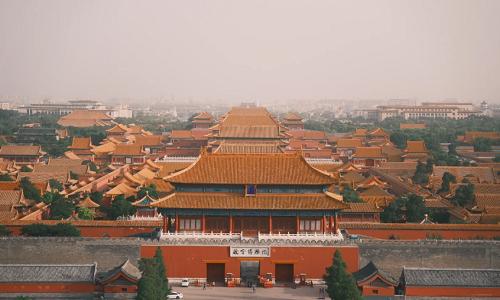
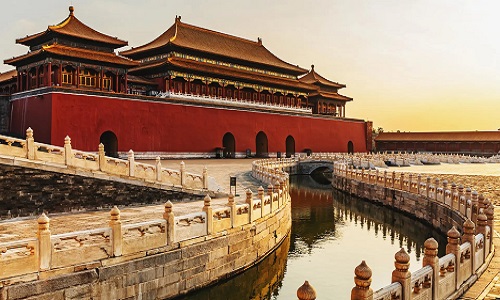
2. Beihai Park: Tranquil Beauty and Imperial Elegance
Just north of Zhongnanhai lies Beihai Park, one of China’s oldest and most beautiful imperial gardens. Once directly connected to Zhongnanhai by waterways, it was a favorite leisure spot for emperors seeking calm and inspiration. Dominated by the iconic White Dagoba atop Qionghua Island, the park features willow-lined paths, stone bridges, and shimmering lake views that mirror the refined landscape of Zhongnanhai itself. Visitors can take a peaceful boat ride or enjoy panoramic vistas of old Beijing’s skyline. The shared history between Beihai and Zhongnanhai reflects the ancient ideal of harmony between nature and governance — a reminder that beauty and power once coexisted within the same imperial domain.
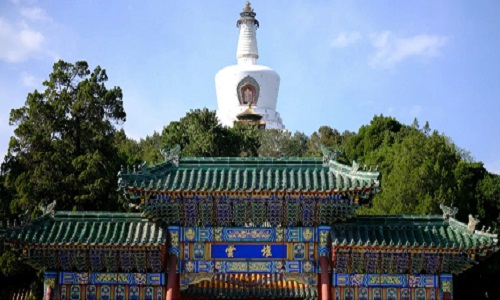
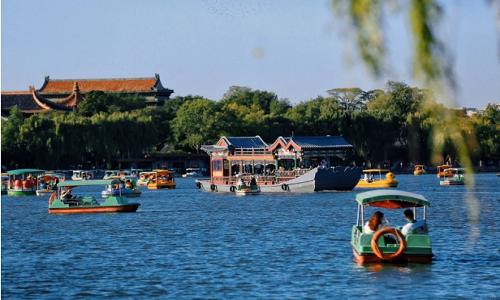
3. Jingshan Park: A Hilltop View Over Beijing’s Heritage
Located just north of the Forbidden City, Jingshan Park offers one of the best panoramic views in Beijing — and, on a clear day, a glimpse of Zhongnanhai’s western edge. Originally an imperial garden built with soil excavated from the Forbidden City’s moats, the park’s central hill, Wanchun Pavilion, provides a stunning perspective of the symmetrical layout that defines Beijing’s historic core. From here, visitors can appreciate the alignment between the Forbidden City, Zhongnanhai, and the city’s main north-south axis — a masterpiece of urban design rooted in feng shui. The peaceful hilltop is not just a photographer’s favorite but also a symbolic spot where one can reflect on centuries of Chinese political and cultural transitions.
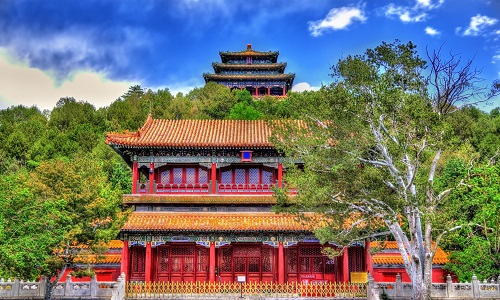
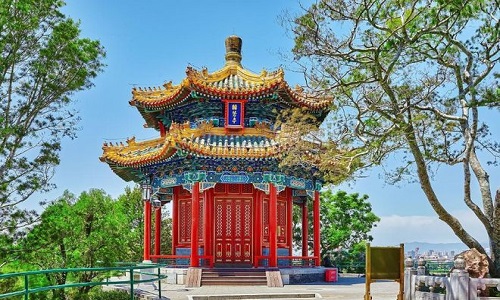
4. Tiananmen Square: The Symbolic Heart of Modern China
To the southeast of Zhongnanhai lies Tiananmen Square, one of the world’s largest and most symbolic public spaces. As the epicenter of China’s modern identity, it hosts national ceremonies, parades, and moments that have defined the country’s path. Facing the Gate of Heavenly Peace and the entrance to the Forbidden City, the square embodies both historical grandeur and revolutionary spirit. From the Monument to the People’s Heroes to the Great Hall of the People, every structure represents China’s journey from empire to republic. The close proximity of Tiananmen Square and Zhongnanhai is deeply symbolic — together they form the physical and ideological heart of Beijing, where the legacy of emperors meets the governance of a modern nation.
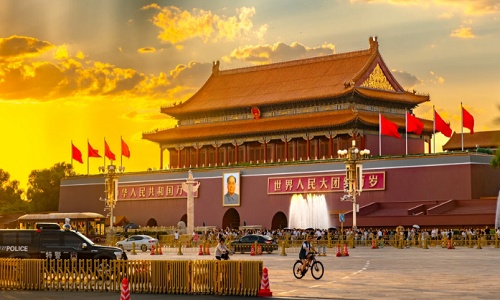
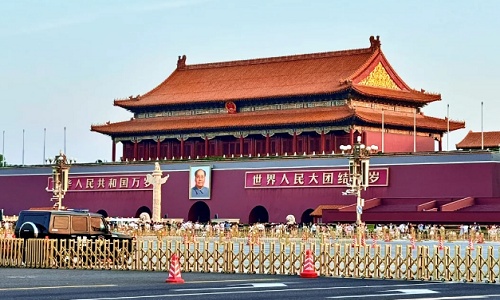
How to View Zhongnanhai from Outside
1. West Chang’an Avenue
This grand avenue runs along the southern edge of Zhongnanhai and is one of the best spots for a distant yet impressive view. From here, you can see the iconic red walls and traditional-style gates that stand in sharp contrast to the modern buildings nearby. It’s a place where the pulse of Beijing’s political and historical heart can truly be felt. The avenue itself is wide, lined with trees and often patrolled by security, so visitors should remain respectful and avoid obstructing traffic while taking photos. Early morning or late afternoon light enhances the texture of the walls, adding warmth to your shots.
2. Fuyou Street Gate
The north gate on Fuyou Street is perhaps the most recognizable entrance to Zhongnanhai. Above the main doorway hangs the famous “Zhongnanhai” plaque, written in elegant calligraphy that symbolizes authority and heritage. While access beyond the gate is strictly prohibited, simply standing before it offers a sense of awe — a reminder of the power and history within. The surrounding area is typically calm, with locals passing by quietly. If you visit during weekdays, you’ll often see government staff entering and exiting nearby offices, giving you a glimpse of the complex’s ongoing administrative life.
3. Photography Tips
Photography around Zhongnanhai requires caution and awareness. While it’s acceptable to take distant exterior shots from public roads, visitors should avoid photographing guards or security checkpoints. The best time for photography is during the golden hour — around sunrise or sunset — when the soft light enhances the contrast between the red walls and green pines. Wide-angle shots from West Chang’an Avenue work best for capturing scale, while zoom lenses from Jingshan Park or Beihai Park can help frame elegant rooflines. Always maintain a respectful distance and comply with posted rules to ensure a smooth experience.
4. Respectful Behavior
Because Zhongnanhai serves as a working government compound, visitors must follow all security instructions. Entry is not permitted, and areas immediately surrounding the walls are often monitored. Keep your voice low, avoid lingering near guarded gates, and refrain from taking intrusive photos. Treat the site as both a living institution and a historic symbol — a place that deserves quiet respect. Appreciating Zhongnanhai from the outside is not just about sightseeing, but also about acknowledging its ongoing role in China’s political and cultural narrative.
Cultural Reflection & Modern Importance
Zhongnanhai stands as a living symbol of China’s seamless transition from imperial authority to modern governance, embodying both tradition and progress. Once an imperial retreat where emperors sought peace beside tranquil waters, it has evolved into the political nerve center of the People’s Republic of China — home to the State Council and the Communist Party’s central leadership. This transformation captures China’s broader story: a nation rooted in ancient civilization yet continually redefining its place in the modern world. The compound’s architecture and layout still echo Ming and Qing dynasty aesthetics, reflecting respect for harmony, order, and balance — values deeply embedded in Chinese political thought. Today, Zhongnanhai is not just a government headquarters; it is a cultural symbol of continuity and resilience, representing China’s pursuit of stability, unity, and national rejuvenation. Its influence extends beyond politics — shaping global perceptions of China as a country that honors its past while steering confidently into the future.
Fun Facts & Secrets: Hidden Stories of Zhongnanhai
Zhongnanhai is filled with intriguing facts and little-known secrets that reveal its unique blend of history, culture, and politics. Its name literally means “Central and Southern Seas,” a reference to the two main lakes — Zhonghai and Nanhai — that form the heart of the compound and once provided serene landscapes for emperors’ leisure. Originally, Zhongnanhai was part of an expansive imperial garden that extended to nearby Beihai Park, creating a continuous space of natural beauty and imperial elegance. Over the years, the compound has gained an air of mystery, with rumors of underground tunnels linking it to the Great Hall of the People, used for confidential movements and communication. Adding to its historic charm, the famous plaque above the main gate, bearing the name “Zhongnanhai,” was personally inscribed by Chairman Mao Zedong, symbolizing the connection between China’s revolutionary era and its imperial past. These hidden stories and architectural details make Zhongnanhai not only a political hub but also a fascinating cultural landmark shrouded in history, secrecy, and symbolism.
Travel Tips for Visitors Nearby: Making the Most of the Zhongnanhai Area
1. Walk Along West Chang’an Avenue and Nearby Landmarks
Begin your exploration along West Chang’an Avenue, which runs adjacent to Zhongnanhai. From here, you can admire the imposing red walls and gates while walking toward Tiananmen Square, China’s symbolic political center. Continue north to Beihai Park, whose lakes and gardens were historically connected to Zhongnanhai. This walking route combines modern city views with historic sites, allowing visitors to experience the atmosphere of the capital while gaining context about the compound’s location and significance. Comfortable shoes are essential, as the route covers several kilometers.
2. Best Time to Visit: Early Morning or Sunset
For the optimal experience, plan your visit during early morning or sunset. Mornings offer quieter streets, softer light, and fewer tourists, providing an opportunity for peaceful observation and photography. Sunset casts a warm glow over the red walls and surrounding gardens, enhancing the visual appeal of your shots. Visiting at these times also allows you to avoid the intense midday heat in summer or harsh shadows in winter. Planning around these hours ensures a more relaxed and visually rewarding experience of the Zhongnanhai area.
3. Explore Nearby Hutongs and Local Culture
Venture into the traditional hutongs near Zhongnanhai to discover local life and cultural experiences. Narrow alleys hide charming tea houses, street food stalls, and small shops selling snacks and crafts. This area offers a chance to observe Beijing residents’ daily routines, enjoy authentic cuisine, and soak in the historic ambiance. Many hutongs have maintained their Ming and Qing-era architecture, providing a complementary contrast to the grand political compounds nearby. Walking through these alleys allows for a more intimate, human-scale perspective of Beijing’s cultural heritage.
4. Consider a Guided City Tour for Historical Insight
To fully appreciate Zhongnanhai’s significance, consider joining a guided city tour that includes commentary on its history and role in Chinese governance. Knowledgeable guides can provide context about the compound’s imperial origins, revolutionary events, and current function, enriching your visit far beyond surface-level observation. Tours often combine nearby attractions such as Tiananmen Square, the Forbidden City, and Beihai Park, creating a comprehensive experience. With a guide, visitors can navigate the area efficiently, gain insider stories, and ensure respectful behavior around sensitive sites while maximizing understanding and enjoyment.
Cultural Reflection & Visitor Experience: Witnessing the Heart of Beijing from Afar
Even though Zhongnanhai is strictly off-limits to the public, its very presence shapes the character of central Beijing and offers a profound cultural experience. The compound stands as a unique intersection where centuries of imperial legacy meet the realities of modern political power, symbolizing both continuity and authority in the heart of the nation. Observing its red walls, serene lakes, and traditional pavilions from nearby streets or parks allows visitors to connect with the unseen stories that have shaped China’s destiny. From the Ming and Qing emperors who once strolled through its gardens to the modern leaders who now make critical national decisions within its halls, Zhongnanhai embodies the persistence of history alongside the dynamic governance of contemporary China. For tourists and history enthusiasts, glimpsing the compound from outside provides an opportunity to reflect on the intricate balance between tradition and modernity, authority and culture, while appreciating the symbolic role it continues to play in defining Beijing’s political and cultural identity.
Top Experiences at the Forbidden City Recommended by Your Way Holiday
We design private and Tailor-made Beijing Tours customized to your style of travel at affordable local prices. We will provide a private & spacious car and a local professional tour guide with over 5 years guiding experience only work for you or your group. Transport, ticket, and dining (We find the most authentic dishes popular with locals) all we will arrange for you according your requirements. Please check our most popular tours below:
{Bottom Links}
Are the above sample tour programs not suitable for you? Dont worry, our Beijing tours can be tailor-made based on your requirements and budget to create unique Beijing experiences that allow you to interact with the local people and culture. We are Beijing travel experts who know what your guidebook and foreign agencies don't. Our enthusiastic tour expert will promptly reply you in details within 24 hours.
Duration:7-8 Hours
Attractions(Cities):Tiananmen Square, Forbidden City, Temple of Heaven, Summer Palace
Tour Style:Experience the heart of Beijing on this one-day tour, designed to immerse you in the city’s rich history, culture, and beauty. Visit iconic landmarks such as Tiananmen Square, the Forbidden City, the Temple of Heaven, and the Summer Palace. Each site offers a unique glimpse into China’s imperial past, with expert guides sharing captivating stories and insights that bring history to life. As you explore, you’ll gain a deeper understanding of Beijing’s cultural heritage, from its grand palaces to its tranquil gardens. This Beijing tour offers personalized service, ensuring a comfortable and seamless experience. Whether you're a first-time visitor or returning to explore more, this tour is the perfect way to discover Beijing’s timeless treasures in a single, unforgettable day.
Duration:2 Days, 1 Night
Attractions(Cities):Temple of Heaven, Tiananmen Square, Forbidden City, Nanluoguxiang, Mutianyu Great Wall, Summer Palace
Tour Style:Embark on a fascinating 2-day adventure in Beijing, where history and modernity blend seamlessly. Begin with the majestic Temple of Heaven and the iconic Tiananmen Square, before discovering the grandeur of the Forbidden City, an imperial treasure trove. Explore the lively Nanluoguxiang, where traditional architecture meets vibrant city life. On day two, enjoy breathtaking views from the Mutianyu Great Wall, a marvel of ancient engineering, and immerse yourself in the serene beauty of the Summer Palace, with its lush gardens and elegant pavilions. This thoughtfully crafted tour offers the perfect mix of historical insights and cultural experiences, designed to captivate your senses and spark your curiosity, leaving you with lasting memories of Beijing.
Duration:3 Days, 2 Nights
Attractions(Cities):Tiananmen Square, Forbidden City, Temple of Heaven, Jingshan Park, Summer Palace, Kunming Lake Boat Riding, Nanluoguxiang, Panjiayuan Antique Market, Mutianyu Great Wall, Bird's Nest, Water Cube
Tour Style:Immerse yourself in Beijing’s rich history and vibrant culture with our exclusive 3-day private tour. Start by exploring Tiananmen Square and the majestic Forbidden City, then visit the serene Temple of Heaven. Enjoy sunset views from Jingshan Park and a scenic boat ride on Kunming Lake at the Summer Palace. Wander through the lively Nanluoguxiang Hutong, hike the breathtaking Mutianyu Great Wall, and marvel at the modern Bird’s Nest and Water Cube. This personalized tour seamlessly blends historical landmarks, cultural experiences, and stunning architecture, ensuring an unforgettable journey. Every moment is designed to captivate, inspire, and leave you with lasting memories of Beijing’s unique charm and diverse beauty.
Duration:5 Days, 4 Nights
Attractions(Cities):Mutianyu Great Wall, Bird's Nest, Water Cube, Qianmen Street, Morning Market, Forbidden City, Tiananmen Square, Jingshan Park, Temple of Heaven, Nanluoguxiang, Facial Makeup Painting, 798 Art Zone
Tour Style:Immerse yourself in Beijing’s rich culture and history with our comprehensive Beijing tour package. This thoughtfully crafted itinerary takes you to iconic landmarks such as the Mutianyu Great Wall, Forbidden City, and Tiananmen Square, alongside modern architectural wonders like the Bird’s Nest and Water Cube. Experience local life at Qianmen Street and the Morning Market, and discover the city’s vibrant art scene at the 798 Art Zone. Engage in hands-on activities, including traditional facial makeup painting. With expert guidance from a seasoned Beijing travel expert, this tour seamlessly combines historical exploration with cultural immersion, offering an unforgettable Beijing experience. Each moment is designed to leave you with lasting memories of this dynamic city.
Duration:10+ Hours
Attractions(Cities):Terracotta Warriors and Horses Museum
Tour Style:Embark on a captivating day trip from Beijing to Xi'an to explore the iconic Terracotta Warriors. This Beijing-Xi'an tour offers a fascinating journey through ancient Chinese history, highlighting the world-renowned Terracotta Army. Visit this monumental archaeological site, home to thousands of life-sized soldiers, horses, and chariots, each crafted with intricate details. With the guidance of an expert, learn about the historical significance of these remarkable figures and their role in China’s ancient imperial past. Enjoy seamless travel and smooth logistics, ensuring a stress-free experience as you delve into the history and culture of this extraordinary site. This day trip promises an enriching and memorable exploration of one of China’s most treasured landmarks.
Wechat: Chinaprivatetour
24 Hours Hotline:
+86 137-3541-1378
(Your Privacy is Protected)
1 to 1 tailor-made service from our professional travel advisors for the most sophisticated
Constantly excellent reviews for attraction, hotel and service Competitive price
Local experts provide quality tours Best selected knowledgeable local guides Authentic local restaurants
7*24 hours available to create you a worry-free tour. No Hidden Fees and absolutely no pressure to buy. Secured









Copyright © 2017 Chinabeijingprivatetour.com All rights reserved. 浙ICP备18056007号-2